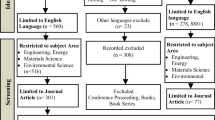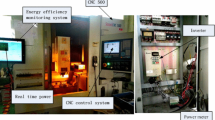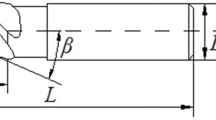Abstract
For improving energy efficiency of machining process, extensive studies focused on how to establish energy consumption model and optimize cutting parameters. However, the existing methods lack a systematic method to promote the widespread use of energy efficiency methods in industry. This paper proposes a systematic method integrating energy model, experiment design, and multi-objective optimization model. Firstly, the energy model is established considering cutting energy and non-cutting energy. Then, the orthogonal experiment is designed with the three levels of four factors of spindle speed, feed speed, cutting depth, and cutting width in the X and Y cutting directions. The data of energy consumption, surface quality, and machining time are obtained to study the effects of different cutting elements and cutting directions. Meanwhile, the standby, spindle idling, feed, SEC (specific energy consumption), material cutting, and idling feed models of the CNC machine tools are established based on the experimental data. Additionally, five sets of experimental data are tested for verifying the accuracy of the established energy consumption model, which can reach 99.4%. Finally, a multi-objective optimization model for high efficiency and energy saving of processing process is established to optimize the cutting parameters considering energy consumption, processing time, and surface quality simultaneously. Combining the case of milling with constraints including machine tool performance, tool life, processing procedures, and processing requirements, the Pareto solution set is used to solve the Pareto of the target model. Through drawing a three-dimensional needle graph and two-dimensional histogram, the optimal cutting parameter combination for rough machining and semi-finish machining is provided assisting in promoting the application of the sustainable techniques in the industry.











Similar content being viewed by others
Availability of data and material
All the data have been presented in the manuscript.
References
Gardner research (2015) World Machine-Tool Output and Consumption Survey. https://www.docin.com/p-1395261450.html?docfrom=rrela
Dahmus JB, Gutowski TG (2004) An environmental analysis of machining. Proc 2004 ASME Int Mech Eng Congr RD&D Expo 643–652
Gutowski TG, Dahmus J, Thiriez A (2006) Electrical energy requirements for manufacturing processes. 13th CIRP Int Conf Life Cycle Eng Lueven
Rajemi MF, Mativenga PT, Aramcharoen A (2010) Sustainable machining: selection of optimum turning conditions based on minimum energy considerations. J Clean Prod 18(10):1059–1065
Munoz AA, Sheng P (1995) An analytical approach for determining the environmental impact of machining processes. J Mater Process Technol 53(3):736–758
Yoon HS, Moon JS, Pham MQ, Lee GB, Ahn SH (2013) Control of machining parameters for energy and cost savings in micro-scale drilling of PCBs. J Clean Prod 54(9):41–48
Mori M, Fujishima M, Inamasu Y, Oda Y (2011) A study on energy efficiency improvement for machine tools. CIRP Ann Manuf Technol 60(1):145–148
Salonitis K, Ball P (2013) Energy efficient manufacturing from machine tools to manufacturing systems. Procedia Cirp 7(12):634–639
Diaz N, Redelsheimer E, Dornfeld D (2011) Energy consumption characterization and reduction strategies for milling machine tool use. Glocalized Solut Sustain Manuf
David NK (2002) A power assessment of machining tools. Massachusetts Inst Technol
Yoon HS, Lee JY, Kim MS, Ahn SH (2014) Empirical power-consumption model for material removal in three-axis milling. J Clean Prod 54–62
Jeswiet J, Kara S (2008) Carbon emissions and CESTM in manufacturing. CIRP Ann Manuf Technol 57(51):17–20
Nicla F, Andrea M, Luca F, Fulvio R (2013) Modeling energy states in machine tools: an automata based approach. 20th CIRP Int Conf Life Cycle Eng Singapore 203–208
Liu N, Zhang YF, Lu WF (2015) A hybrid approach to energy consumption modelling based on cutting power: a milling case. J Clean Prod 104:264–272
Agapiou JS (1992) Optimization of machining operations based on a combined criterion, part 1: the use of combined objectives in single-pass operations. J Manuf Sci Eng 114(4):500–507
Solimanpur M, Ranjdoostfard F (2009) Optimization of cutting parameters using a multi-objective genetic algoritm. Int J Prod Res 47:6019–6036
Krishna AG, Rao KM (2006) Multi-objective optimisation of surface grinding operations using scatter search approach. Int J Adv Manuf Technol 29(5–6):475–480
Saravanan R, Asokan P, Sachidanandam M (2002) A multi-objective genetic algorithm approach for optimization of surface grinding operations. Int J Mach Tool Manuf 42:1327–1334
Campatelli G, Lorenzini L, Scippa A (2014) Optimization of process parameters using a Response Surface Method for minimizing power consumption in the milling of carbon steel. J Clean Prod 66(2):309–316
Hanafi I, Khamlichi A, Cabrera FM, Almansa E (2012) Optimization of cutting conditions for sustainable machining of PEEK-CF30 using TiN tools. J Clean Prod 33(8):1–9
Camposeco-Negrete C (2013) Optimization of cutting parameters for minimizing energy consumption in turning of AISI 6061 T6 using Taguchi methodology and ANOVA. J Clean Prod 53(16):195–203
Zhou LR, Li JF, Li FY, Meng Q, Li J, Xu XS (2016) Energy consumption model and energy efficiency of machine tools: a comprehensive literature review. J Clean Prod 112:3721–3734
Kara S, Li W (2011) Unit process energy consumption models for material removal processes. CIRP Ann Manuf Technol 60(1):37–40
Velchev S, Kolev I, Ivanov K, Gechevski S (2014) Empirical models for specific energy consumption and optimization of cutting parameters for minimizing energy consumption during turning. J Clean Prod 80:139–149
Khorram E, Khaledian K, Khaledyan M (2014) A numerical method for constructing the Pareto front of multi-objective optimization problems. J Comput Appl Math 261:158–171
Meng Y (2019) Energy consumption modelling in milling process and parameters optimization. Harbin Univ Sci Technol 82–83
Goldberg DE (2006) Genetic algorithms in search, optimization and machine learning 2104–2116
Acknowledgements
Guozhen Bai, Yilong Wu, and Xiang Chen are thanked for providing technical support during the experiments.
Funding
This research is funded by the National Natural Science Foundation of China Grant No. 51605294.
Author information
Authors and Affiliations
Contributions
Chunhua Feng: conceptualization, methodology, software, validation, writing-original draft, funding acquisition. Haohao Guo: investigation, data curation, software. Jingyang Zhang: investigation, data curation, resources. Yugui Huang: investigation, data curation, resources. Shi Huang: methodology, software, validation, writing-original draft.
Corresponding author
Ethics declarations
Ethics approval
Not applicable.
Consent to participate
The authors declare that they all consent to participate this research.
Consent for publication
The authors declare that they all consent to publish the manuscript.
Conflict of interest
The authors declare no competing interests.
Additional information
Publisher's note
Springer Nature remains neutral with regard to jurisdictional claims in published maps and institutional affiliations.
Rights and permissions
About this article
Cite this article
Feng, C., Guo, H., Zhang, J. et al. A systematic method of optimization of machining parameters considering energy consumption, machining time, and surface roughness with experimental analysis. Int J Adv Manuf Technol 119, 7383–7401 (2022). https://doi.org/10.1007/s00170-022-08772-6
Received:
Accepted:
Published:
Issue Date:
DOI: https://doi.org/10.1007/s00170-022-08772-6




